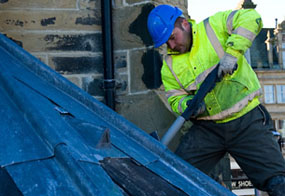Lead thefts continue to plague churches across the nation
 Thankfully, the rates of metal theft have reduced greatly from the levels of a couple of years ago, thanks mainly to the proactively of police forces up and down the country, and more recently to the Scrap Metal Dealers Act, (SMD Act) which was introduced in October 2013.
Thankfully, the rates of metal theft have reduced greatly from the levels of a couple of years ago, thanks mainly to the proactively of police forces up and down the country, and more recently to the Scrap Metal Dealers Act, (SMD Act) which was introduced in October 2013.
Unfortunately that will be of little comfort to the congregations of five churches, spread across the country, who have all recently fallen victim to this horrendous crime.
Not only does this highlight the fact that there are still thieves motivated enough to steal the lead, there are also unscrupulous Scrap Metal Dealers who are willing to buy the metal. The fact that all these offences have taken place since the introduction of the new law, shows that there are still problems with metal theft and the recycling industry.
St John's Church in Bridgewater, Somerset was hit by thieves who stole lead from the roof, and which allowed water ingress in several places. The thieves were described by the vicar of St John's Rev Geraldine Kirk, as 'despicable chancers'. The church which has fallen victim of metal thieves in the past is now facing a bill of many thousands of pounds to repair the damage.
Thieves also struck at another Somerset church, this time St. Nicholas' Church in Radstock. Extensive damage was caused during the commission of the crime, and the offence was first discovered when torrential rain water gushed inside the church damaging plaster columns, the wooden roof and carpets. It was found that the main central gully of the Grade II listed building had been stolen by the thieves. Again, repairs are likely to cost many of thousands of pounds.
Scottish churches are also not immune, and Saint Salvador's Church, in Dundee was recently attacked twice within a short period of time. The BBC recently reported that thousands of pounds of damage had been caused to the ornate interior of the church and Church rector the Reverend Clive Clapson said the thieves were "stealing from some of the poorest people in Scotland".
Interestingly, the SMD legislation does not apply in Scotland, and there is some evidence of cross boarder activity both to steal and dispose of the metals. The Scottish and Northern Ireland administrations are to follow Westminster in the introduction of similar legislation, but the timescales involved are as yet unknown.
Back in England, thieves have also struck on the Fylde coast, with the dome of Lytham Methodist Church being hit twice in three days. Large sections of the ornate lead dome have been stolen leaving the congregation 'outraged' at the crimes. It is reported that 25 square meters of lead sheet have been taken, and the Rev. Adrian Burdon has said that the church will have to dip into its reserves to fund the repairs. The church is also reportedly approaching Methodist Insurance for assistance.
In July 2014, thieves stole lead from the roof of St Thomas the Apostle, Leesfield, Greater Manchester, causing water ingress which damaged an organ and pew cushions. This was the latest of five attacks at this church in as many years, and has left a local councillor Val Sedgwick 'furious' over the crime and has caused 'devastation' throughout the congregation.
The new legislation was never going to be a complete solution to metal theft, although there is no doubt that it has had a positive impact. The causes of crime and the motivation of offenders are known to be complex issues, with no easy answers.
A constant factor however, is the ability of the thieves to dispose of the stolen lead. Quite simply, if they cannot sell it, they won't steal it!
Lead as we know is a highly recyclable material, and at some stage that stolen lead must pass into the legitimate market. There is a constant challenge therefore to equip the legitimate traders with the means to easily identify stolen lead. Marking lead with Trace-in-Metal provides this traceability and allows both thief and reciever to know that the lead can be traced, throughout the recycling process.
If the legitimate trader knows it is stolen, they won't buy it and this puts downward pressure on unscrupulous traders and thieves.
Until that happens, church roofs will unfortunately continue to be stolen, and congregations will continue to foot ever increasing bills to keep their precious lead on the roof.
For further information, visit www.trace-in-metal.com
















